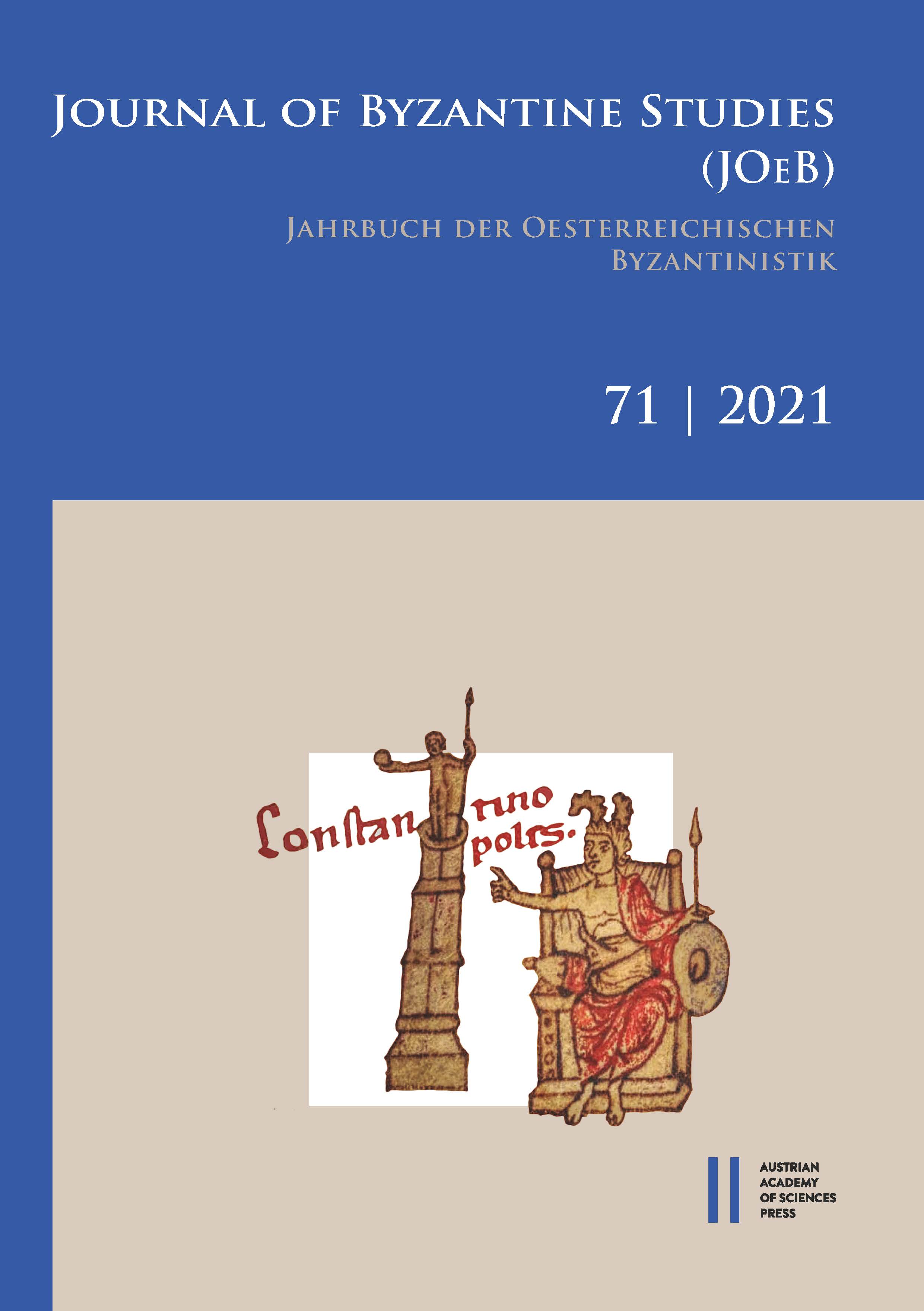|
 |
Die einmal jährlich erscheinende Zeitschrift wurde 1951 als Jahrbuch der Österreichischen Byzantinischen Gesellschaft gegründet; mit dem Wechsel in den Verlag der Österreichischen Akademie der Wissenschaften wurde sie 1973 (ab Band 22) in Jahrbuch der Österreichischen Byzantinistik umbenannt. Sie stellte zunächst einerseits das Publikationsorgan von Byzantinist:innen Österreichs dar – stets interdisziplinär offen zu allen Nachbarwissenschaften –, andererseits ein Fachmedium, das international Beiträge zum Fachgebiet nach einem Begutachtungsverfahren veröffentlicht(e). Mittlerweile zählt das Jahrbuch zu einer der führenden Zeitschriften der Byzantinistik international.
Mit Band 68 (2018) führte die Zeitschrift die thematische Bündelung von Themen in Cluster mit einer kurzen Einleitung ein. So wurden etwa Schwerpunkte den Autoren Theodoros Studites oder Georgios Pisides gewidmet.
Die starke internationale Nachfrage, aber auch Kriterien der Indizierung haben zu einer erneuten Namensänderung 2021 geführt: Ab Band 71 trägt die Zeitschrift den Doppeltitel Austrian Journal of Byzantine Studies (JOEB) / Jahrbuch der Österreichischen Byzantinistik.
Inhaltlich umfasst die Zeitschrift Neueditionen oder Ersteditionen griechischer Texte (auf der Quellbasis von Siegeln über Inschriften zu Handschriften) mit philologischen und historischen Kommentaren ebenso wie Studien jedweder wissenschaftlichen Fokussierung, einschließlich Archäologie und Kunstgeschichte. Ein besonderes Anliegen ist der Zeitschrift dabei auch die interdisziplinäre Bandbreite und die Einbeziehung von Nachbarkulturen im politisch-kulturellen Austausch mit Byzanz.
Artikel
Beatrice DASKAS, πτερόν, πτέρυξ, πτερύγιον. A Cultural-Historical Study of a Classical
Greek Architectural Term and Derivatives, and their Post-Classical Meaning
Arne EFFENBERGER, Topographica corrigenda. Annakirche am Deuteron – columna virginea
– Nikolaoskloster – Doppelkloster der Theotokos Kecharitomene und des Christos Philanthropos
Christophe ERISMANN, John the Grammarian and Photius. A Ninth-Century Byzantine
Debate on Depiction, Visual Perception and Verbal Description
Christian GASTGEBER, Byzanz und das Konzil zu Basel und Ferrara. Neue Dokumente der
Kaiser- sowie Patriarchatskanzlei und der Umgang mit Latein im Kontakt mit dem Westen
Filip HORÁČEK, The Astronomical Situation and a Hitherto Unregistered Comet in Synesius’
Calvitii encomium 10, 5 / 209, 8–14
Nikoletta KANAVOU, Reflections on the Relationship between the Life and Passion of Saints
Galaktion and Episteme and the Ancient Greek Novel
Katharina KASKA, Zur hochmittelalterlichen Überlieferung von Maximus Confessor, Capita
de caritate in der Übersetzung des Cerbanus
Ewald KISLINGER, Drei lateinische Lesefrüchte zu res byzantinae
Dirk KRAUSMÜLLER, Assertive Bishops and a Wily Emperor. Nicholas Mouzalon on the
Election of Patriarch Nicholas III Grammatikos (1084)
Lev LUKHOVITSKIY – Varvara ZHARKAYA, The Age of Πειθανάγκη. A Note on Remembrance
and Reinvention of Ancient Words under the Komnenoi
Caroline MACÉ – Patrick ANDRIST, Understanding the Genesis of a Multi-Layered Byzantine
Manuscript. The Illuminated Copy of Elias of Crete’s Commentary on Gregory Nazianzen
(Basel, UB, AN I 8)
Filip VAN TRICHT, Who murdered Archbishop William of Rouen (†1217)? The Valley of
Philippi under Latin Rule (1204–circa 1224/25)
CLUSTER 1: GEORGE OF PISIDIA
Nicole KRÖLL, Introduction
Alice COSME, “Ποίαν γλώττης οὐκ ἐκίνησεν λύραν;” Poetic Style and Diction in the Bellum
Avaricum of George of Pisidia
Anna Maria TARAGNA, Leo Choirosphaktes, Reader of George of Pisidia. Notes on the
Language and Style of the So-Called Thousand-Line Theology
Nadine VIERMANN, Merging Supreme Commander and Holy Man. George of Pisidia’s Poetic
Response to Heraclius’ Military Campaigns
Mary WHITBY, The Patriarch Sergius and the Theotokos
CLUSTER 2: DISCONTINUITY REVISITED. INTELLECTUAL ACTIVITIES IN SEVENTH- AND EIGHTHCENTURY
BYZANTIUM AND ARMENIA
Christophe ERISMANN, Introduction
Benedetta CONTIN, Intertwining Aristotelian Ontology and Logic with Theology. The Early
Armenian Non-Chalcedonian Perspective. The Book of Beings and the Questions
Addressed to the Heretical Diophysites
Peter COWE, The Inception of Armenian Grammatical Thought out of the Matrix of Hellenic
Paideia
Vessela VALIAVITCHARSKA, Rhetorical Education Between the Seventh and the Ninth Century
Besprechungen
Dimitris K. AGORITSAS, Βίος καὶ πολιτεία τῶν ὁσίων Νεκταρίου καὶ Θεοφάνους τῶν Ἀψαράδων κτιτόρων τῆς Ἱερᾶς
Μονῆς Βαρλαάμ. Βίος – διαθηκῷον γράμμα – ἐγκωμιαστικὰ κείμενα (Eirini Afentoulidou-Leitgeb)
Coptica Palatina, Koptische Texte aus der Heidelberger Papyrussammlung (P.Heid.Kopt.), ed. A. BOUD’HORS –
A. DELATTRE – G. SCHENKE – T. S. RICHTER – G. SCHMELZ (Stefan Bojowald)
Jean-Claude CHEYNET, Les sceaux byzantins de la collection Yavuz Tatış (Werner Seibt)
Leah DI SEGNI – Yoram TSAFRIR – Judith GREEN, The Onomasticon of Iudaea-Palaestina and Arabia in the Greek and
Latin Sources, Vol. II, Part I and II (Basema Harmarneh)
Andrei GANDILA, Cultural Encounters on Byzantium’s Northern Frontier, c. AD 500–700: Coins, Artifacts and History
(Johannes Preiser-Kapeller)
Andreas E. GKOUTZIOUKOSTAS, Θεσσαλονίκεια επιγραφικά μελετήματα. Χρονολογικές και ερμηνευτικές προσεγγίσεις
βυζαντινών κτητορικών επιγραφών από τα τείχη της πόλης και τη βασιλική του Αγίου Δημητρίου (Andreas Rhoby) 516
Martin HURBANIČ, The Avar Siege of Constantinople in 626. History and Legend (Nikolas Hächler)
Andrija JAKOVLJEVIĆ, Κατάλογος Χειρόγραφων Κωδίκων Βυζαντινής Μουσικής Ιεράς Αρχιεπισκοπής Κύπρου
(Gerda Wolfram)
Emma LOOSLEY LEEMING, Architecture and Asceticism: Cultural Interaction between Syria and Georgia in Late
Antiquity (Annegret Plontke-Lüning)
Robert G. OUSTERHOUT, Visualizing Community. Art, Material Culture and Settlement in Byzantine Cappadocia
(Neslihan Asutay-Effenberger)
|



 Home
Home
 Print
Print
 References
References
 Share
Share
